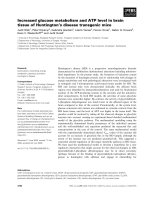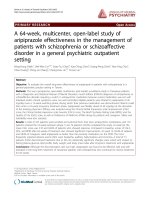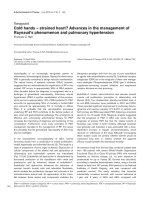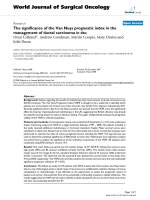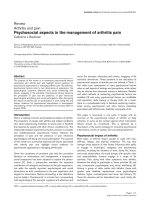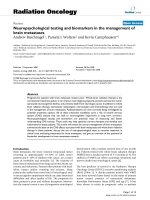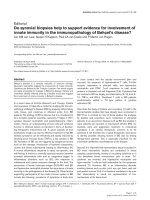Failures in logistics management of vinalink s logistics department and recommendations
Bạn đang xem bản rút gọn của tài liệu. Xem và tải ngay bản đầy đủ của tài liệu tại đây (366.06 KB, 48 trang )
I
NATIONAL ECONOMICS UNIVESITY
ENGLISH FOR BUSINESS DEPARTMENT
FACULTY OF FOREIGN LANGUAGES
¬
LE THI THUY LINH
INTERNSHIP report
Topic:
FAILURES IN LOGISTICS MANAGEMENT OF
VINALINK’S LOGISTICS DEPARTMENT AND
RECOMMENDATIONS
II
Hanoi- 5/2010
I
NATIONAL ECONOMICS UNIVESITY
ENGLISH FOR BUSINESS DEPARTMENT
FACULTY OF FOREIGN LANGUAGES
¬
LE THI THUY LINH
INTERNSHIP report
Topic:
FAILURES IN LOGISTICS MANAGEMENT OF
VINALINK’S LOGISTICS DEPARTMENT AND
RECOMMENDATIONS
Field:
English for Business Studies
Code:
701
Supervisor: MS. NGUYEN PHUONG HOAI,
M.A
Hanoi- 5/2010
II
ACKNOWLEDGEMENTS
This study is completed not as the result of my personal effort
but the outcome of enthusiastic support and contribution from
many people involved in my internship process.
Therefore, I would like to thank Ms. Trần Thị Thu Giang, Dean
of Faculty of Foreign Languages for giving me the opportunity to
conduct this study. I am also delighted to give my sincere
recognition and appreciation to Ms Nguyễn Phương Hoài for her
constant help with academic knowledge and her support during
the time I complete my report.
I would also like to express my gratitude to Vinalink
International Freight Forwarders particularly Logistics DepartmentHa Noi Branch for allowing me to do internship in the company. I
especially owe my thanks to people who directly instructed me
who
are
Mr.
Nguyễn
Quốc
Vương,
Manager
of
Logistics
Department and other officials of the department.
Once again, I deeply appreciate all the great support that I
received during my internship.
III
EXECUTIVE SUMMARY
This report provides an analysis on the failure of Logistics
Department-Ha Noi Branch of Vinalink International Freight
Forwarders in terms of logistics management.
Data collected through methods of observation, horizontal and
vertical analysis of revenue, growth and proportion shows that
revenue of Logistics Department has moderate increase over the
time. However, the rate of revenue which Logistics Department
contributes to the total number of the whole branch is rather low
despite the fact that logistics is one of the most popular services
recognized by Vinalink’s customers and partners. Its revenue
contribution is outnumbered by those of Air and Sea Departments.
This situation is the result of inefficient logistics management.
Its management failures are shown the most clearly in two of its
revenue generating sources: warehouse and freight transport.
Therefore, a management reform is the key solution to help
Logistics Department overcome its drawbacks and attain greater
competitive strength among other departments of Ha Noi Branch.
Recommendations discussed in this report include:
Improve warehouse management
Improve freight transport management
IV
INTRODUCTION
Rationale
Together with the growth of Vietnam’s economy in general
and business sector in particular, the need for exchanging and
transporting goods is getting greater and greater. Logistics has
appeared to fill this market gap. In transport context, logistics is
referred to as the planning, organization, management, execution
and control of freight transport operations which determines the
efficiency of freight transport. Up to now, logistics has become a
business with the emergence of new companies as well as
specialized departments within existing transport organizations.
Vinalink International Freight Forwarders (Vinalink) is a longtime player in this business. Since its establishment in 1999,
Vinalink has provided logistics services in combination with its
International transport services and from 2002 these services have
been managed by specialized departments in Ha Noi, Hai Phong
and Ho Chi Minh City. Among those three departments, Logistics
Department of Hanoi Branch has become a popular provider of
these services. However, as a specialized department with its own
management Logistics Department has failed to prove its role in
revenue contribution into the total number of the whole office in
comparison
with
other
departments
Departments. This results from its
such
as
Sea
and
Air
inefficient management.
Therefore, in this study, I analyzed some drawbacks of Logistics
Department in terms of logistics management from which I could
draw some recommendations to solve the situation.
Methodology
In this report I based on three main research methods to
present my ideas and arguments, which are observational method,
quantitative method and descriptive method
Research questions:
V
My report gives answers to the following questions:
-
What are issues of logistics management?
-
What are Logistics Department’s failures in logistics
management?
-
How can Logistics Department improve its management?
Sources and method of data collection
Analysis in my report primarily based on secondary data such
as
statistics
organizational
of
revenue,
records.
rates
The
data
of
revenue,
was
growth
collected
and
through
observation, Vinalink’s performance reports and minutes of
meetings.
VI
TABLE OF CONTENT
CHAPTE
R
TITLE
PAGE
Title page...........................................................................I
Acknowledgement...........................................................II
Executive summary........................................................III
Introduction....................................................................IV
Table of content.............................................................VI
Main chapters..................................................................1
Introduction of Vinalink International Freight
1 Forwarders and Logistics Department .......................1
1.1.Vinalink International Freight Forwarders’ background. 1
1.2. Logistics Department’s background.............................3
1.3. Logistics Department’s performance...........................4
Literature review.............................................................7
2 2.1. Logistics.......................................................................7
2.2. Logistics management.................................................8
2.2.1. Warehouse management.......................................8
2.2.1.1. Use of building space........................................8
2.2.1.2. Minimum movement.......................................10
2.2.1.3. Control and information system......................10
2.2.1.4. Product integrity.............................................11
2.2.1.5. Working condition and safety..........................11
2.2.2. Freight transport management............................11
2.2.2.1. Choice of transport modes..............................11
2.2.2.2. Scheduling and routing control.......................13
2.2.2.3. Fleet management..........................................13
Analysis and findings....................................................15
3 3.1. Warehouse management...........................................15
3.1.1. Warehouse design and layout..............................15
3.1.2. Information and communication system..............17
3.1.3. Working condition and safety...............................18
3.2. Freight transport management..................................18
Recommendations.........................................................21
VII
4 4.1. Warehouse management reform...............................21
4.1.1. Warehouse design and layout.................................21
4.1.2. Information and communication system.................23
4.1.3. Working condition and safety..................................23
4.2. Freight transport management reform.......................24
Conclusion......................................................................26
Appendix.........................................................................28
References......................................................................29
1
CHAPTER I
INTRODUCTION OF VINALINK INTERNATIONAL
FREIGHT FORWARDERS AND LOGISTICS
DEPARTMENT
Chapter 1 provides an overview of Vinalink International
Freight Forwarders’ business and after that zooms in the operation
of Logistics Department of Vinalink Ha Noi Branch to introduce its
main areas of services. In addition, Logistics Department’s
performance is evaluated in order to find out its current situation.
1.1.
Vinalink
International
Freight
Forwarders’
background
Vinalink International Freight Forwarders or Vinalink for
abbreviation founded under the decision of Minister for Ministry of
Trade to equitize state-owned company, officially started its
operations on September 01, 1999 as a Joint Stock company with
10% state-owned, and 90% individual-owned, with starting capital
of VND8 billion.
Vinalink is headquartered at 145 – 147 Nguyen Tat Thanh,
District 4, Ho Chi Minh City and has branches and representative
offices in Ha Noi, Hai Phong, Binh Duong, Da Nang, Quy Nhon,
Dong Nai…
Vinalink has more than 270 employees and owns over 2.500
sq m of office building, 16.000 sq m of warehouse and open yards,
over 40 prime movers, trucks and pick-up vans, loading and
unloading equipments and devices.
Vinalink’s scope of business includes:
- Freight forwarding (Seafreight and Airfreight)
- Transport services
- Logistics services
- Bonded warehouse and cargo storage services
2
- Shipping and Liner Agency
- GSA (General sales agent) for airlines
- Air ticket booking agency
- Import - export and trading business
- Infrastructure investment and real estate business
As a trustworthy partner of cooperation Vinalink has achieved
membership of honorable associations of freight forwarders as well
as economic organizations such as Vietnam Freight Forwarders
Association-VIFFAS, International Federation of Freight ForwardersFIATA, American Moving and Storage Association-AMSA and
Vietnam Chamber of Commerce and Industry-VCCI…
Vinalink Ha Noi Branch
Vinalink Ha Noi Branch was launched on January 1 st, 2005 at
No.2 Bich Cau Street, Dong Da District, Ha Noi. In 2006 its office
was moved to level 6, Lang Ha Builiding, Ba Dinh District, Ha Noi.
Until the end of the year 2009, Ha Noi Branch had 70 employees
working in 6 departments. The organizational structure of Ha Noi
Branch is described in Figure 1.
Figure 1: Organizational structure of Ha Noi Branch
3
Ha Noi Branch
A
Ocean Export Ocean
Dept. Import Dept.
Airfreight Dept.
Logistics
Hai Phong
1.2. Logistics Department’s background
Logistics services have been provided by Vinalink since its
official establishment to assist international transport services.
Since 2002, logistics services have been separated into specialized
departments in Ho Chi Minh City, Ha Noi, and Hai Phong.
There are five main services being provided by Logistics
Department consisting of:
-
Logistics services for import and export cargoes: such as
custom declaration, import export formality, project and exhibition
cargoes delivery, door to door delivery, cargoes packaging and
wrapping, crating, import export consulting, certificate of origin,
insurance, fumigation, culture checking, authorized import and
4
export formalities, local inland transit and on forwarding from main
ports to province.
-
Delivery
services
for
import
cargoes:
take
care
of
distribution services including transport to warehouse, storage,
classification,
unloading
and
loading,
delivery
to
required
destinations or on-site, payment on behalf of shippers…
-
Transport services: which include container transport and
break-bulk cargoes, office removal, factory removal, household
and personal effects removal, transport of transit cargoes to Laos,
Cambodia and China.
-
Warehouse and bonded warehouse services are composed
of storage and distribution, bonded warehouse services and
mortgaged cargo management services for Banks.
-
Services providing to shipping lines at terminals are
services related to ships and crew, shipping boarding agency,
packages tallying, containers tallying, cargoes tallying for loading
into
containers,
export
and
import
consolidation
and
de-
consolidation operations at Container Freight Station terminals and
buyer’s consolidation.
Logistics Department of Ha Noi Branch is currently utilizing
350 sq m of warehouse and fleet of more than10 container trucks,
vans and forklifts. Logistics Department of Ha Noi Branch is also
responsible for managing logistics services provided by Hai Phong
office. Human resource of Logistics Department consists of 30
officers
for
different
posts:
01
logistics
manager
and
01
representative of Hai Phong office, 03 customer service officers,
02 documentation officers, 08 operation officers, 01 accountant,
03 transporters and 11 drivers (01 in Ha Noi and 10 in Hai Phong).
1.3. Logistics Department’s performance
During two years 2008 and 2009 Logistics Department had a
moderate growth in revenue with an increase of 63.77% of the
department’s total revenue. Container trucking accounted for the
5
greatest proportion of revenue contributing to the total and was
the sector with the most remarkable growth in two years which
nearly doubled its revenue in 2009. Other sectors also had tender
rise in revenue except for railway sector which lost more than half
of its revenue in 2009. Detailed information is shown in Table 1.
Table 1: Logistics Dept.’s Revenue 2008-2009 (Unit:
USD)
2008
2009
Growth
(2009/200
Implemented
8)
year
Sector
Warehouse
12,458.43
20,078.96
161.17%
Inland Ha Noi
10,455.86
12,749.97
121.94%
Inland Hai Phong
28,791.84
49,289.41
171.19%
Railway
10,846.21
4,131.82
38.09%
Container
44,499,51
88,996.52
199.99%
107,041.50
175,306.14
163.77%
trucking
Total
Logistics Department contributed its revenue into the total
number of the whole branch by 21.09% in 2008 and 26.49% in
2009. Although Logistics Department had rising proportions of
revenue contribution from 2008 to 2009 it still lost the biggest
share to Airfreight Department in 2008 and Ocean Import
Department in 2009. That information is presented in Table 2,
Figure 2 and Figure 3
6
Table 2: Ha Noi Branch Revenue 2008-2009 (Unit: USD)
Implemented
year
Department
Airfreight
Ocean Import
Ocean Export
2008
2009
Reven
Proport
Revenu
Proporti
ue
ion
e
on
(USD)
(%)
(USD)
(%)
171,206.
33.74 203,101.0
30.68
44
0
146,769.
28.93 211,149.4
66
8
82,431.1
16.24 72,459.98
10.94
107,041.
21.09 175,306.1
26.49
50
4
31.89
6
Logistics
Total
507,44
100.00
8.76
662,016.
100.00
60
Figure 2: Revenue contribution 2008 by departments
21.09
%
16.24%
33.7
28.93
%
Figure 3: Revenue contribution 2009 by departments
7
26.49
%
30.68
%
10.94
%
31.89
%
There may be many reasons for Logistics Department
situation, one of those is inefficient management which will be
analyzed as the focus of this report. The following chapters of my
report aimed at finding the answers to some questions:
-
What are issues of logistics management that contribute to
performance and result of logistics organizations?
-
What practices of logistics management did Logistics
Department
Ha
Noi
Branch
fail
to
apply?
What
was
the
consequence of its failure?
-
How
can
Logistics
Department
improve
its
logistics
management to overcome the problems?
Research methodology and methods of data collection
This report used observational method to observe and record
how management tasks are performed by Logistics Department in
order to point out some drawbacks emerging in the middle of its
operation process. Basing on quantitative method, it analyzed
numerical statistics from the company’s performance reports and
minutes of internal meetings such as its revenue, rates of revenue
to draw a clear picture of Logistics Department’s situation
concerning its growth, position and competitive strength among
other departments. Moreover, carried out as a descriptive
research, this report aims at identifying the underlying causes
leading to Logistics Department weaknesses from which proper
recommendations can be given out.
8
Scope of the research
This report analyzes failure of Logistics Department - Hanoi
Branch of Vinalink International Freight Forwarders in logistics
management, focusing on two aspects which are the main profitgenerating
sources
of
Logistics
Department:
warehouse
management and freight transport management. These two
aspects are discussed at length throughout literature review,
analysis and recommendation chapters.
In the close-up of the performance of Logistics Department,
some problems in logistics management have arisen. In the latter
part of my report, I will introduce the theoretical framework for
logistics management on which I can draw a clear picture for the
department
situation,
especially
its
failures
in
applying
management principles which result in its current weaknesses.
9
CHAPTER 2
LITERARURE REVIEW
Chapter 2 presents the theoretical framework for analyses and
arguments of my report. It is responsible for answering the
question
about
management
issues
which
contribute
to
performance of logistics organizations. It is also the guide to
instruct the building of effective logistics management strategies.
2.1. Logistics
The term “logistics” originates from the ancient Greek word
“logos” – “ratio, word, calculation, reason, speech, and oration”.
And “Logistikas” was the title of ancient Greek military officers
who were responsible for financial and supply distribution matters.
By the time the term is more and more widely used in many
aspects beyond the boundary of military activities. Nowadays, the
most general definition of “logistics” is:
“Logistics is the management of the flow of goods,
information and other resources, including energy and
people, between the point of origin and the point of
consumption
in
order
to
meet
the
requirements
of
consumers”. (Wikipedia)
However it is not easy to have complete understanding of
“Logistics” because its definition varies in different aspects. In the
context of transport which is the scope of my research the term
“logistics” should be understood as follows:
“Logistics is the strategic management movement,
storage and information relating to materials, parts and
finished goods in supply chains, through the stages of
procurement, work-in-progress and final distribution. Its
overall goal is to contribute to maximum current and future
1
0
profitability through the cost effective fulfillment of customer
orders.” (Cooper, ed, 1994)
“Logistics is… the positioning of resource at the right
time, in the right place, at the right cost, at the right quality.”
(UK Institute of Logistics and Transport, 1998)
“Logistics is the efficient movement of finished
product from the end of the production line to the consumer,
and in some cases includes the movement of raw materials
from the source of supply to the beginning of the production
line.
These
warehousing,
activities
include
material
handling,
freight
transportation,
protective
packaging,
inventory control, plant and warehouse site selection, order
processing, marketing forecasting and customer service.” (US
National Council of Physical Distribution Management (NCPDM)
To sum up, logistics is a business activity which manages the
physical distribution of goods and materials from producers (or
shippers) to consumers (or consignees), through the stages of
warehousing, manufacturing and distribution, in order to fulfill
customers orders.
2.2. Logistics management
Like
management
of
any
other
businesses,
logistics
management includes tasks of planning, implementing, and
controlling logistics operation. One of the most detailed definitions
of logistics management is presented by Council of Supply Chain
Management Professionals (CSCMP)
“Logistics management is the governance of supply
chain functions. Logistics management activities typically
include inbound and outbound transportation management,
fleet management, warehousing, materials handling, order
fulfillment, logistics network design, inventory management,
1
1
supply/demand planning, and management of third party
logistics services providers.”
In my report, due to the scope of my study I focused my
analysis on two among many aspects of logistics management:
warehouse management and freight transport management.
2.2.1. Warehouse management
Warehouse has a prime objective which is to facilitate the
movement of goods from suppliers to consumers. Services
provided by warehouses include stock holding, packaging and
repackaging,
incorporating
value-added
activities,
such
as
postponement, as a means of reducing the number of stock
keeping units (SKUs) in a system and increasing the flexibility to
meet customer requirements.
There
are
five
principles
for
an
effective
warehouse
management
2.2.1.1. Use of building space
Warehouse space represents a very significant proportion of
total warehouse costs, so space should be used effectively.
Warehouse manager can think of some considerations for effective
space utilization.
Firstly, warehouse design and layout should make effective
use of building height rather than counting on its floor area. There
are many suggestions for achieving better use of height, for
example, using mezzanine floors where appropriate.
Secondly, warehouse should be organized in a way that
minimizes aisle numbers and widths consistent with access and
safety.
Thirdly, it is more advisable to use random location systems
for stock rather than fixed locations. Fixed location system assigns
specific location for a designated product line and never for any
other product. Consequently, the installation must be designed
with enough capacity to hold the maximum stock of every product

